 Here is video of the 11 April 2008 dedication of the Elsie Quarterman Cedar Glade Wildflower Festival at Cedars of Lebanon State Park,
posted on YouTube 29 January 2009 by the MTSU Center for Cedar Glade Studies.
Here is video of the 11 April 2008 dedication of the Elsie Quarterman Cedar Glade Wildflower Festival at Cedars of Lebanon State Park,
posted on YouTube 29 January 2009 by the MTSU Center for Cedar Glade Studies.
-jsq
 In the Tennesseean today,
Elsie Quarterman (1910 – 2014)
In the Tennesseean today,
Elsie Quarterman (1910 – 2014)
ObituaryContinue readingElsie Quarterman, Nashville, TN
A Memorial service will be held at 10 a.m., Saturday, June 21, 2014 at Westminster Presbyterian Church, 3900 West End Avenue, with a reception at the church following the service. Guestbook crawfordservices.com.
Crawford Mortuary & Crematory, 615-254-8200.
 Today Aunt Elsie stepped over the final fence,
dying peacefully at her home in Nashville, Tennessee,
attended by her nephew Patrick and his wife Ann,
as she had wanted.
Today Aunt Elsie stepped over the final fence,
dying peacefully at her home in Nashville, Tennessee,
attended by her nephew Patrick and his wife Ann,
as she had wanted.
Arrangements are still in progress. Perhaps more about the family later. For now, here is a biography with some pictures.
 The Wilson Post wrote 20 April 2011,
Quarterman shares fervor for cedar glades,
The Wilson Post wrote 20 April 2011,
Quarterman shares fervor for cedar glades,
…her passion for the plant life of Middle Tennessee’s cedar glades blooms ever strong through the generations of students she inspired at Vanderbilt University from the 1940s into the mid-1970s. And those students, many now teachers themselves, continue to inspire new students and conservationists….
Continue reading
Elsie Quarterman is 102 years old today.
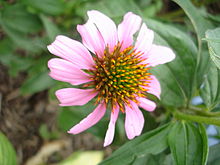 She was born in Valdosta in 1910,
played basketball for Hahira High School,
graduated from Valdosta High School,
got a B.A. from Valdosta State College,
and taught English in Morven, Naylor, Columbus,
Lake Park, and Lyons, Georgia.
She was born in Valdosta in 1910,
played basketball for Hahira High School,
graduated from Valdosta High School,
got a B.A. from Valdosta State College,
and taught English in Morven, Naylor, Columbus,
Lake Park, and Lyons, Georgia.
Dr. Elsie Quarterman got a Masters and a Ph.D. from Duke University in
in botany and plant ecology.
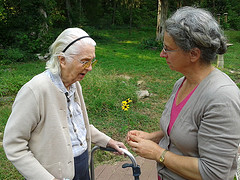 While studying for her Ph.D., she was a professor at Vanderbilt University
in Nashville, Tennessee, where she
was one of the first women full professors and was the first
woman department chair (Biology).
She specialized in the cedar glades of central Tennessee,
including
one now named after her by the state.
While studying for her Ph.D., she was a professor at Vanderbilt University
in Nashville, Tennessee, where she
was one of the first women full professors and was the first
woman department chair (Biology).
She specialized in the cedar glades of central Tennessee,
including
one now named after her by the state.
 There is an annual
wildflower festival
named after her.
She rediscovered the cedar glade Tennessee coneflower, Echinacea tennesseensis,
which previously was thought to be extinct,
but has
since been taken off the endangered species list,
partly due to her work.
Her wikipedia page
has more information about her work and her many honors.
There is an annual
wildflower festival
named after her.
She rediscovered the cedar glade Tennessee coneflower, Echinacea tennesseensis,
which previously was thought to be extinct,
but has
since been taken off the endangered species list,
partly due to her work.
Her wikipedia page
has more information about her work and her many honors.
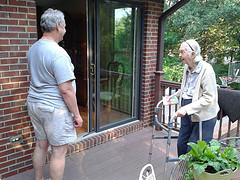 Aunt Elsie still lives in her own house in Nashville, connected to her nephew
Patrick’s house, where Patrick and his wife Ann live and take care of her.
Aunt Elsie still lives in her own house in Nashville, connected to her nephew
Patrick’s house, where Patrick and his wife Ann live and take care of her.
Here is world traveller Elsie in 2006 leading a family group on the Isle of Skye in Scotland:
Continue readingPatrick, Gretchen, Elsie, Ann:
Patrick, Gretchen, Elsie, Ann
Pictures by John S. Quarterman for Okra Paradise Farms, Nashville, Tennessee, 2 July 2012.
Elsie, Patrick, Ann:
Continue readingMy grandmother wrote this around 1960, when she was around 77 years old. -jsq
I remember when corn in the fields was dropped by hand — 2 grains every two steps. Mule plow opened the furrow & children dropped the grains.
The first corn planter was considered bad — it was sure to keep the seed from sprouting!
My brother Patrick found this text in a notebook his aunt Elsie had kept.
-jsq
Elsie and the river book:
Elsie Quarterman with Wayne Morgan’s Satilla River photography book
At 100 101 years and four months, Vanderbilt Emerita Prof. of Plant Ecology Elsie Quarterman sat up to see these pictures. Later she started paging through it to see some of them again.
Wayne Morgan has taken thousands of photographs of the Satilla River, especially in Brantley County.
-jsq
 Aunt Elsie gets mentioned again for her pioneering career in plant ecology.
Aunt Elsie gets mentioned again for her pioneering career in plant ecology.
According to the Nature Conservancy (undated), Tennessee Coneflower — No Longer Endangered
After years of hard work and the support of many dedicated individuals, an iconic flower is once again thriving in Tennessee. On August 4, 2011, the U.S. Fish and Wildlife Service announced the removal of the Tennessee coneflower from the Endangered Species List, marking an extraordinary recovery from the brink of extinction. The story of the coneflower exemplifies the power of conservation.Her nephew Patrick found this.In 1968, Vanderbilt biology professor Elsie Quarterman and graduate student Barbara Turner accidentally discovered the fuschia-colored coneflowers at Mount View Cedar Glade. The plant had been thought extinct until the rediscovery. In time, three other coneflower sites were discovered in Davidson and Wilson counties. In 1979, the Tennessee coneflower became one of the first plants to be recorded on the Endangered Species List.
Quarterman subsequently became a trustee of the Tennesee Chapter of The Nature Conservancy and urged the protection of the cedar glade habitats where the Tennessee coneflower and other rare plants have adapted to live in harsh, stony conditions.
-jsq
 WSMV in Nashville reports that
the Tennessee purple coneflower, which grows only in cedar glades,
and only in three counties in the world,
is being taken off the endangered species list:
WSMV in Nashville reports that
the Tennessee purple coneflower, which grows only in cedar glades,
and only in three counties in the world,
is being taken off the endangered species list:
 Less than one percent of endangered species ever get taken off the list.
The
Tennessean reports:
Less than one percent of endangered species ever get taken off the list.
The
Tennessean reports:
The U.S. Fish and Wildlife Service plans to officially remove the wildflower by Sept. 2, from its list of plants that are near extinction.“The Tennessee coneflower’s recovery is an example of what can be achieved through the combined efforts of dedicated partners,” said Cindy Dohner, the Service’s Southeast Regional Director, in an emailed announcement.
Echinacea tennesseensis was thought extinct until Dr. Elsie Quarterman rediscovered it in 1969 in the cedar glades which are her academic specialty. She was 59 then.
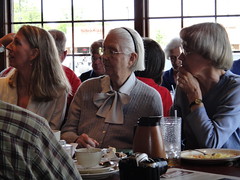 Now she is 100, and still being honored
by her students
and by her state.
Now she is 100, and still being honored
by her students
and by her state.
Aunt Elsie
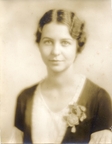 was born in Valdosta and played basketball for Hahira High School,
before she started her very long career in botany and plant ecology.
was born in Valdosta and played basketball for Hahira High School,
before she started her very long career in botany and plant ecology.
As aye, Elsie!
-jsq
PS: This post owed to Patrick Quarterman.
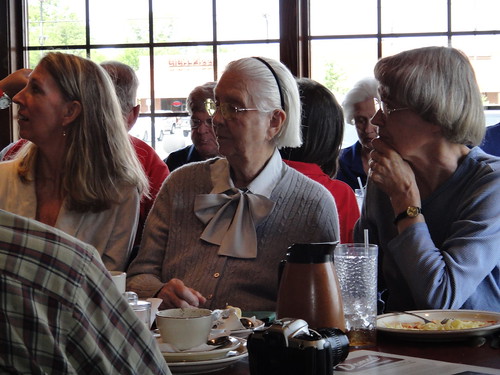
Kim Cleary Sadler,
Assistant Professor of Biology at Middle Tennessee State University
and co-Director of the
Center for Cedar Glade Studies.
(Student of
Thomas “Tom” Ellsworth Hemmerly, who was teaching and couldn’t come.)
Dr. Elsie Quarterman, Professor Emerita of Plant Ecology, Vanderbilt University
Carol C. Baskin, Professor of Biology, University of Kentucky
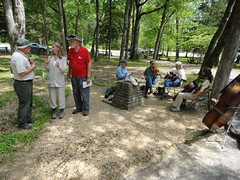 There were classes, botany walks, owl hoots, and musicians.
Here’s the schedule.
It was sunny this year,
unlike last year’s great flood.
Next year, you should come!
Get out of town, take a walk in the glades.
There were classes, botany walks, owl hoots, and musicians.
Here’s the schedule.
It was sunny this year,
unlike last year’s great flood.
Next year, you should come!
Get out of town, take a walk in the glades.
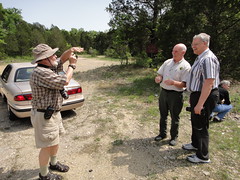 Elsie got a guided tour, with
Tennessee State Naturalist Emeritus Mack Pritchard
and his successor Randy Hedgepath.
Here they are with Elsie’s nephew Patrick Quarterman,
while Gretchen Quarterman photographs a glade.
Elsie got a guided tour, with
Tennessee State Naturalist Emeritus Mack Pritchard
and his successor Randy Hedgepath.
Here they are with Elsie’s nephew Patrick Quarterman,
while Gretchen Quarterman photographs a glade.
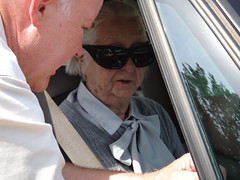 Here
State Naturalist Randy Hedgepath
consults with Dr. Quarterman about identification of a cedar glade plant.
Here
State Naturalist Randy Hedgepath
consults with Dr. Quarterman about identification of a cedar glade plant.
Elsie got out of the car to look at this one with Randy and Ann Quarterman: Continue reading